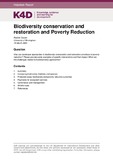| dc.contributor.author | Cooper, Rachel | |
| dc.date.accessioned | 2020-03-24T15:41:31Z | |
| dc.date.available | 2020-03-24T15:41:31Z | |
| dc.date.issued | 2020-03-18 | |
| dc.identifier.citation | Cooper, R.(2020).Biodiversity conservation and restoration, and poverty reduction. K4D Helpdesk Report 773. Brighton, UK: Institute of Development Studies | en |
| dc.identifier.uri | https://opendocs.ids.ac.uk/opendocs/handle/20.500.12413/15180 | |
| dc.description.abstract | Reconciling the twin goals of biodiversity conservation and restoration, and poverty reduction is difficult. A number of factors seem to influence effectiveness across intervention types including context, intervention design, governance and management quality, community engagement and participation, and intervention or programme length. This report largely focuses on outcomes from protected areas, payments for ecosystem services and community-based strategies. Protected areas can range from strictly protected to sustainable use PAs and from government-managed to community-managed areas (Woodhouse & Bedelian, 2018). There is mixed evidence about the biodiversity and poverty reduction outcomes of PAs, but a general sense that PES can lead to positive outcomes in both spheres. There is evidence that PAs have reduced deforestation, but biodiversity outcomes appear to vary by species. One robust study demonstrates that habitat corridors can increase conservation and decrease rates of extinction (Damschen et al., 2019). There is some evidence that PAs have produced negative outcomes for poverty reduction and human well-being, and some evidence that PAs have contributed to poverty alleviation. Positive outcomes across the two spheres from PES programmes include reducing deforestation, improving water quality, increasing food security and improving poverty status (Clements & Milner-Gullard, 2014; Bottazzi et al., 2018). There is some evidence that outcomes are context dependent and related to the length or age of the intervention. Positive poverty reduction outcomes in Nepal’s PAs are partly linked to the length of time the PA in question has been established. Wildlife repopulation, the benefits generated by ecosystem conservation, the development of new models of resource use and the adoption of a new legal framework all take time to establish, as do creating and strengthening human capacities for management and governance (AFD, 2016). Lee (2018) argues that the positive conservation outcomes in the Burunge WMA are linked to its age, its location close to two national parks, Tanzania’s large ecotourism industry, and capacity building for village game scouts and management of the WMA. | en |
| dc.language.iso | en | en |
| dc.publisher | IDS | en |
| dc.relation.ispartofseries | K4D Helpdesk Report;773 | |
| dc.rights.uri | https://www.nationalarchives.gov.uk/doc/open-government-licence/version/3/ | en |
| dc.subject | Climate Change | en |
| dc.subject | Environment | en |
| dc.subject | Governance | en |
| dc.subject | Poverty | en |
| dc.subject | Rights | en |
| dc.subject | Rural Development | en |
| dc.title | Biodiversity Conservation and Restoration and Poverty Reduction | en |
| dc.type | Helpdesk | en |
| dc.rights.holder | © DFID - Crown copyright 2020 | en |
| dcterms.dateAccepted | 2020-03-18 | |
| rioxxterms.funder | Department for International Development, UK Government | en |
| rioxxterms.identifier.project | K4D | en |
| rioxxterms.version | VoR | en |
| rioxxterms.funder.project | 238a9fa4-fe4a-4380-996b-995f33607ba0 | en |

